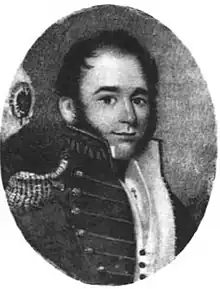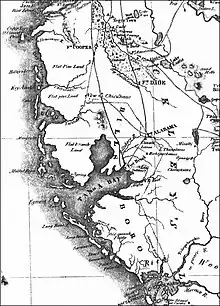Thomas Jefferson Leib | |
|---|---|
 | |
| Born | 1806 Philadelphia, Pennsylvania |
| Died | 14 July 1851 Philadelphia, Pennsylvania |
| Buried | Laurel Hill Cemetery, Philadelphia |
| Allegiance | United States |
| Years of service | 1811–1851 |
| Rank | Commander |
| Commands held | Schooner Motto; Fort Foster |
| Battles/wars | Second Seminole War |
| Spouse(s) | Caroline Matilda Harrison |
Thomas Jefferson Leib was an American naval officer of the early 19th-century sailing ship era, active in Florida's Second Seminole War as well as anti-piracy and smuggling suppression patrols throughout the Gulf of Mexico, Caribbean Sea, and West Indies.
Early life
Thomas Jefferson Leib was born in Philadelphia, Pennsylvania, in 1806. His parents were John Lewis Leib (1775–1838) and Margaret Leib (Vioner) (1778–1836).[1]
Career
Leib was commissioned a midshipman in September 1811.[2][3] Between 1818 and 1820, he served aboard the 74-gun ship-of-the-line USS Franklin.[4] During this time, Franklin cruised the Mediterranean, serving as the flagship of Commodore Charles Stewart.[5] This was followed in 1821 by service in the 14-gun barque USS Spark performing anti-piracy patrols in the West Indies.[3][5] He returned home to Philadelphia in 1822 before serving on the frigate USS Congress, commanded by Capt. James Biddle, in 1823–1824 as it operated as part of the West Indian Squadron against pirates and illicit slavers.[6][3] He continued serving in the West Indies on the 36-gun frigate USS Constellation when it was added to the West Indian squadron in 1825.[7] In 1827 he was on the 12-gun schooner USS Shark engaged in anti-piracy patrol and slave trade suppression.[6][8] During an extended leave of absence between 1828 and 1832, he was promoted to lieutenant.[9] He returned to sea-going duty in 1833 aboard the newly commissioned 10-gun schooner USS Boxer, commanded by Lt. B. Page, as it cruised off the coast of Brazil and in the West Indies.[5][10] After a two-year leave of absence, in 1836, Leib reported for duty on board the USS Concord operating off the coast of west Florida, commanded by Capt. Mervine P. Mix.[5][11]
Second Seminole War
Late in 1835, the U.S. government determined to remove the Seminole Indian tribe of south-central Florida to designated lands west of the Mississippi.[12] After negotiations between the government and Indian leaders broke down, the Seminoles began raiding white settlements and military detachments.[12] The conflict, known as the Second Seminole War, lasted between 1835 and 1842.[13] This conflict was one of the few Indian wars in which the U.S. Navy played a substantial role. The U.S. Army requested that the Navy establish a blockade around Florida.[14] It was long known that the Seminoles maintained trade relations with the Spanish in Cuba, and authorities suspected that arms and provisions were being smuggled in from British Bahamas.

In early June 1836, USS Concord was at Tampa Bay. Leib was directed to take the Army contract schooner Motto, along with a detachment of 20 sailors and Marines, and investigate a reported cache of Seminole gunpowder stored on Indian Key in the northern Florida Keys.[15] He did not find much gunpowder at Indian Key; however, while in the vicinity, he learned of a shipwreck around New River, Florida, with a reported cargo of lead. Leib took the Motto north and was in the vicinity of the shipwreck during the third week of July. He dived on the wreck; no lead was found. On July 23, after hearing a large explosion to the north, Leib sailed the Motto to investigate.[12] Early morning the next day, upon arriving in the vicinity of Cape Florida Light, at the south end of Key Biscayne, he observed the lighthouse and several settlement buildings had been attacked and burned. Leib led a rescue party ashore and discovered both the lighthouse keeper and assistant had sought refuge at the top of the lighthouse.[16] Both were severely injured and trapped up in the lighthouse tower. Unfortunately, the assistant succumbed to his multiple wounds. The wounded lighthouse keeper could not descend from the building; the fire destroyed the stairs. The sailors ran a line up to the tower and jury-rigged a harness so that two crew members could ascend and bring the lighthouse keeper down.[17] After getting the wounded man onboard Motto, Leib transported him to Key West. Leib departed Key West and rejoined USS Concord, which had relocated to Pensacola.

In the fall of 1836, the Army decided to re-occupy the previously abandoned Fort Alabama site. The newly built fortification, consisting of a stockade, storehouse, and magazine, was named Fort Forster in honor of Lieutenant Colonel William Foster, the officer leading the detachment that constructed the works. Located approximately 30 miles northeast of Tampa Bay, the area was adjacent to a bridge across the Hillsborough River.[18]
In December 1836, Commodore Alexander J Dallas, commander of the Navy's West Indian Squadron, conferred in Tampa Bay with Commanding General Thomas Sidney Jessup.[18] The Commodore offered sailors and marines to man several static forts to free army and militia troops to pursue a mobile campaign against the Seminoles.
Aboard USS Concord, located in Tampa Bay, Captain Mix selected Lt. Leib to lead a detachment of two midshipmen and fifty sailors to proceed to Fort Foster.[15] In early January 1837, Leib marched north and garrisoned Fort Foster. Over the next few weeks, Seminole bands attacked the fort and twice tried to burn the bridge. The garrison, under Leib's command, successfully resisted these attacks.[19] Gradually the troops in the field began to withdraw from the swamps and brush and returned to the forts. In March, U.S. Army troops replaced Leib and his sailors.
Upon detaching USS Concord, Leib went on an extended leave of absence. He did not return to active sea duty. He was promoted to commander on March 30, 1844.[20]
Personal life
In June 1828, Leib married Caroline Matilda Harrison (1803–1893) at Priestly Lodge in Philadelphia.[2] Caroline Harrison was the niece of former U.S. Senator for Pennsylvania and Philadelphia postmaster Michael Leib (1760-1822). They had five children: John Lewis (b. 1829), Lydia Virginia (b. 1830), Mary Jacoba (b. 1834), Harrison (b. 1839).[1]
Leib died July 14, 1851, aged 45 years. He is buried in Laurel Hill Cemetery, Philadelphia.[1][2]
References
- 1 2 3 McDaniel, E.L. (20 July 2022). "Thomas Jefferson Leib". ancestry.com.
- 1 2 3 Harrision, William Walsh (1910). Harrison, Waples and allied families : Being the ancestry of George Leib Harrison of Philadelphia and of his wife Sarah Ann Waples. Philadelphia: Edward Stern & Co. p. 66.
- 1 2 3 U.S. Navy Dept. (1821). Navy Register: Register of the U.S. Navy; Year: 1821 (v.1). Navy Department Library: Naval History and Heritage Command.
- ↑ Navy Register: Register of Officers and Agents; Year: 1818 ((v.1) ed.). Washington, DC: Naval History and Heritage Command. 1818.
- 1 2 3 4 Dictionary of American Naval Fighting Ships (vol IV ed.). Washington, DC: Navy Department. 1969.
- 1 2 Dictionary of American Naval Fighting Ships (vol III ed.). Washington, DC: Navy Department. 1963.
- ↑ Navy Register: Officers of the U.S. Navy and Marine; Year: 1825. Washington, DC: Naval History and Heritage Command. 1825.
- ↑ Navy Register: Officers of the U.S. Navy and Marine; Year: 1827 (vol. 1 ed.). Washington, DC: Naval History and Heritage Command. 1827.
- ↑ Navy Register: Officers of the U.S. Navy and Marine; Year: 1832 (v.1 ed.). Washington, DC: Naval History and Heritage Command. 1832.
- ↑ Navy Register: Officers of the U.S. Navy and Marine; Year: 1833 (v.1 ed.). Washington, DC: Naval History and Heritage Command. 1833.
- ↑ Navy Register: Officers of the U.S. Navy and Marine; Year: 1837 (v.1 ed.). Washington, DC: Naval History and Heritage Command. 1837.
- 1 2 3 Mahon, John K. (2017). History of the Second Seminole War, 1835–1842. Gainesville, Florida: LibraryPress@UF.
- ↑ Missall, John & Mary Lou (2015). Florida Seminole Wars Heritage Trail. Dade City, FL: Seminole Wars Foundation, INC.
- ↑ Buker, George E. (1979). "The Mosquito Fleet's Guides and the Second Seminole War". The Florida Historical Quarterly. 57 (3): 308–26. JSTOR 30148526 – via JSTOR.
- 1 2 Penner, Gayle (2003). "Historic Notes and Documents: The Mix Diaries". The Florida Historical Quarterly. 82 (2): 191–218. JSTOR 30149473 – via JSTOR.
- ↑ Viele, John (2011). The Florida Keys, Vol 2: True Stories of the Perilous Straits (vol 2 ed.). Sarasota, FL: Pineapple Press.
- ↑ Thompson, John (20 July 2022). "Statement of John Thompson, Lighthouse Keeper".
- 1 2 Schene, Michael (1976). "Fort Foster: A Second Seminole War Fort". The Florida Historical Quarterly. 54 (3): 319–39. JSTOR 30151289 – via JSTOR.
- ↑ "Land Sailor: The Early History of Swamp Sailors". Retrieved June 7, 2022.
- ↑ U.S. Navy and Marine Corps Officers Registry; Year: 1845. Washington, DC: Naval History and Heritage Command. 1845.